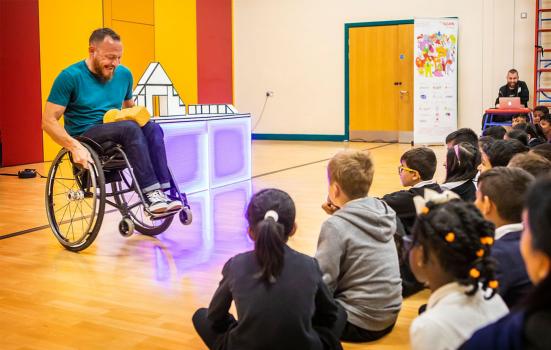Tara Lopez identifies three key themes that have emerged so far from the four-year Vital Spark initiative.

© Pamela Raith Photography
Last year, The Spark Arts for Children launched Vital Spark, a four-year programme with an ambitious aim: to address the lack of diversity in the children’s arts sector. When it launched, I wrote an article in this magazine exploring some of our initial questions. At that point, we recognised the need to look at our own diversity gaps and the power dynamic between us and the artists.
When working with artists we don’t want them to feel as if they’re just here to tick a box
One year on, we’ve begun to see a shift, as well as experiencing some steep learning curves. We've identified three themes to steer the way forward.
One size doesn’t fit all
When we began our recruitment drive, we knew the onus was on us to reach out and turn the ‘hard to reach’ concept on its head. It was us as a sector that was hard to reach, not the artists, so we spent time connecting through roadshow events and direct approaches. It was time well spent: we met over 50 artists and received 37 applications.
Not only is it important for us to consider how we invite these artists into the space, but we must question how we treat them once they’re here. We use the terms BAME, D/deaf and disabled so often that we gloss over the detail, nuance and overlap that lies within them.
When working with artists we don’t want them to feel as if they’re just here to tick a box or that we aren’t seeing them fully. Part of this has been about considering access more wholly – not just for those identifying as D/deaf or disabled but for every individual. We’ve tried to develop an approach that is open and responsive enough for everyone to thrive.
We’ve also been clear not to reduce any of these artists to a label. If we introduce an artist, it will be by telling you their name, artform, passions and interests – and not the part of their identity that made them eligible for the programme.
It’s not enough to question our approach
We must question the entire structure. As a sector, we often focus on how we can work the diversity agenda into the framework that exists. Rarely do we focus on the need to truly review the framework and re-shape it in a way that works for everyone. Not wanting to shy away from this with Vital Spark, but recognising it’s not all within our control, we’ve begun to implement ways to question the structure we operate in.
Internally, we’ve reviewed a number of working practices around access and inclusion and the relationship between artist, programmer and producer. We’re also looking at the way Spark Festival can act as a catalyst for change and a platform for artists and companies.
Externally, we’re finding ways to work in partnership with organisations, putting small changes in place that we hope will lead to a long-term shift. The partnership brings together organisations who are keen to see the lack of diversity in the children’s sector change and are ready to work collaboratively to become more than the sum of their parts.
So far, we have six partners across the country all committing time, space and cash. By working together, we can share learning from Vital Spark and spark new connections with a talented group of artists who can build stronger and wider relationships with venues and organisations.
Marginalisation upon marginalisation
Look at countries like Belgium and Denmark and you will see very little difference in the approach to or respect for children’s work compared to work for adults. Unfortunately, the picture is not the same here. We’ve seen a number of instances where work for children is seen as inferior.
In April, an article in The Independent referred to the National Theatre’s line-up of directors as follows: “Out of six plays there are four new commissions and two revivals. A man has written every one of them. A woman – Amy Hodge – will direct only one, and it’s the kids’ show.”
While the point about gender equality here is relevant, the way the kid’s show is referenced unveils a deep-rooted reality surrounding the children’s sector in this country. It’s viewed as lesser. What impact does this have on diversity in the children’s sector? For artists who already find themselves marginalised, does creating work for children seem like a further marginalisation?
Tara Lopez is Creative Producer of Spark Arts for Children.
https://thesparkarts.co.uk
Vital Spark is open for applications to the 2019–20 programme until Wednesday 21 August. For more information click here.




